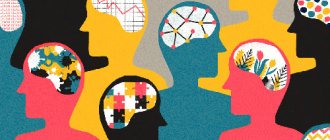The world around us is perceived by a person through his psyche, which forms individual consciousness. It includes the totality of all the individual’s knowledge about the reality around him. It is formed through the process of understanding the world through its perception with the help of 5 senses.
Receiving information from the outside, the human brain remembers it and subsequently uses it to recreate a picture of the world. This happens when an individual, based on the information received, uses thinking, memory or imagination.
Concept of consciousness
With the help of consciousness, a person not only contrasts his “I” with what surrounds him, but is also able to restore pictures of the past with the help of memory, and imagination helps him create what is not yet in his life. At the same time, thinking helps to solve problems that reality poses to an individual on the basis of knowledge gained from its perception. If any of these elements of consciousness are disrupted, the psyche will suffer serious trauma.
Thus, individual consciousness is the highest degree of a person’s mental perception of the reality around him, in which his subjective picture of the world is formed.
In philosophy, consciousness is always opposed to matter. In ancient times, this was the name for a substance capable of creating reality. This concept in this understanding was first introduced by Plato in his treatises, and then it formed the basis of the Christian religion and philosophy of the Middle Ages.
Types of rational knowledge
Rational knowledge can be divided into two fundamental types: value-humanitarian and logical-conceptual. Each of these parts corresponds to different areas of activity of our consciousness, as well as the subtleties of its functioning. Let's consider each of the approaches in more detail.
- Value-based and humanitarian. Despite the fact that the general approach is rational, there is a place in it for seemingly non-rational objects, such as culture. However, this is an erroneous judgment. To talk about categories such as “culture” requires a conceptual framework and meaning embedded in this term, which is impossible without a rational approach. That is, the rational approach is used here to evaluate non-rational categories.
- Logical-conceptual. This category includes abstract, ideal objects or models, the use of which makes it possible to determine the existing relationships between objects or phenomena and their general characteristics. This approach is most effective in the exact sciences.
Consciousness and matter
Materialists have narrowed the functions of consciousness to the property of an entity that cannot exist outside the human body, thereby putting matter in first place. Their theory that individual consciousness is matter generated exclusively by the human brain has no basis. This can be seen in the contrast of their qualities. Consciousness has no taste, no color, no smell, it cannot be touched or given any form.
But it is also impossible to accept the theory of idealists that consciousness is an independent substance in relation to a person. This is refuted by the chemical and physical processes that occur in the brain when an individual perceives the surrounding reality.
Thus, scientists have come to the conclusion that consciousness is the highest form of the psyche, reflecting existence, which has the ability to influence and transform reality.
Bibliography
- Philosophy, textbook // Ed. Lavrinenko V.V. - M.: 2004;
- Philosophy, textbook for university students // ed. V.P. Kokhanovsky - Rostov n/a: 1998;
- Alekseev P.V., Panin A.V. Philosophy, textbook. M. - 2003;
- Kuznetsov V.G., Kuznetsova I.D., Mironov V.V., Momdzhyan K.Kh. Philosophy, textbook. M.: 2004;
- modern philosophy: dictionary and reading notes;
- Smirnov I., Titov V. Philosophy, textbook.-Moscow: 2004;
- Spirkin A.G. Philosophy, textbook, M.: 2006;
- Balashov L.E. Philosophy, textbook-M.: 2005;
- Alekseev P.V., Panin A.V. Epistemology and dialectics. M.: 1991.
- Barulin V.S. Fundamentals of socio-philosophical anthropology. - M.: 2002.
.
Components of consciousness
When describing its structure, it should be taken into account that it is two-dimensional:
- On the one hand, it contains all the collected information about external reality and the objects that fill it.
- On the other hand, it also contains information about the individual himself, who is the bearer of consciousness, which, with development, passes into the category of self-consciousness.
Individual consciousness forms a picture of the world, which includes not only external objects, but also the person himself with his thoughts, feelings, needs and actions to realize them.
Without the process of self-knowledge, there would be no human development in the social, professional, moral and physical spheres, which would not lead to an awareness of the meaning of one’s own life.
Consciousness consists of several blocks, the main ones of which are:
- The processes of knowing the world through the senses, as well as its perception through sensations, thinking, speech, language and memory.
- Emotions that convey the subject’s positive, neutral or negative attitude towards reality.
- Processes associated with making and executing decisions and volitional efforts.
All blocks together provide both the formation of a person’s certain knowledge about reality and satisfy all his urgent needs.
What is rational knowledge?
Rational cognition (from the Latin “ratio” - reason) is a special way of obtaining information, which inherently relies on information obtained by a person using reason. This is one of the special ways of reflecting reality, which is characteristic only of humans. It has fewer limitations than sensory cognition.
The main feature of rational knowledge is the ability to penetrate into the true essence of objects, things and phenomena from the point of view of logic. Thanks to the use of rational thinking, it is possible to significantly expand the existing boundaries of sensory knowledge , since most of the logical chains are inaccessible to sensory knowledge. Such connections can only be considered using thinking.
Social consciousness
In philosophy and psychology there is such a concept as the relationship between social and individual consciousness. It should be taken into account that the social is a product of individual or collective concepts that were formed over a long period of observation of reality, its objects and ongoing phenomena.
The very first forms of social consciousness formed in human society were religion, morality, art, philosophy, science and others. For example, observing natural elements, people attributed their manifestations to the will of the gods, creating public knowledge about these phenomena through individual conclusions and fears. Collected together, they were passed on to subsequent generations as the only truth about the surrounding world inherent in a given society. This is how religion was born. People belonging to other nations with opposite social consciousness were considered infidels.
Thus, societies were formed, the majority of whose members adhered to generally accepted principles. People in such an organization are united by common traditions, language, religion, legal and ethical standards, and much more.
To understand how social and individual consciousness are interconnected, you should know that it is the second that is primary. The consciousness of one member of society can influence the formation or change of the social, for example, as was the case with the ideas of Galileo, Giordano Bruno and Copernicus.
LiveInternetLiveInternet
The world around us is perceived by a person through his psyche, which forms individual consciousness. It includes the totality of all the individual’s knowledge about the reality around him.
It is formed through the process of understanding the world through its perception with the help of 5 senses. Receiving information from the outside, the human brain remembers it and subsequently uses it to recreate a picture of the world. This happens when an individual, based on the information received, uses thinking, memory or imagination. The concept of consciousness With the help of consciousness, a person not only contrasts his “I” with what surrounds him, but is also able to restore pictures of the past with the help of memory, and imagination helps him create what is not yet in his life. At the same time, thinking helps to solve problems that reality poses to an individual on the basis of knowledge gained from its perception. If any of these elements of consciousness are disrupted, the psyche will suffer serious trauma. Thus, individual consciousness is the highest degree of a person’s mental perception of the reality around him, in which his subjective picture of the world is formed. In philosophy, consciousness is always opposed to matter. In ancient times, this was the name for a substance capable of creating reality. This concept in this understanding was first introduced by Plato in his treatises, and then it formed the basis of the Christian religion and philosophy of the Middle Ages.
Consciousness and matter Materialists have narrowed the functions of consciousness to the property of an entity that cannot exist outside the human body, thereby putting matter in first place. Their theory that individual consciousness is matter generated exclusively by the human brain has no basis. This can be seen in the contrast of their qualities. Consciousness has no taste, no color, no smell, it cannot be touched or given any form. But it is also impossible to accept the theory of idealists that consciousness is an independent substance in relation to a person. This is refuted by the chemical and physical processes that occur in the brain when an individual perceives the surrounding reality. Thus, scientists have come to the conclusion that consciousness is the highest form of the psyche, reflecting existence, which has the ability to influence and transform reality.
Components of consciousness When describing its structure, it should be taken into account that it is two-dimensional:
- On the one hand, it contains all the collected information about external reality and the objects that fill it.
- On the other hand, it also contains information about the individual himself, who is the bearer of consciousness, which, with development, passes into the category of self-consciousness.
Individual consciousness forms a picture of the world, which includes not only external objects, but also the person himself with his thoughts, feelings, needs and actions to realize them. Without the process of self-knowledge, there would be no human development in the social, professional, moral and physical spheres, which would not lead to an awareness of the meaning of one’s own life. Consciousness consists of several blocks, the main ones of which are:
- The processes of knowing the world through the senses, as well as its perception through sensations, thinking, speech, language and memory.
- Emotions that convey the subject’s positive, neutral or negative attitude towards reality.
- Processes associated with making and executing decisions and volitional efforts.
All blocks together provide both the formation of a person’s certain knowledge about reality and satisfy all his urgent needs.
Social consciousness In philosophy and psychology there is such a concept as the relationship between public and individual consciousness. It should be taken into account that the social is a product of individual or collective concepts that were formed over a long period of observation of reality, its objects and ongoing phenomena. The very first forms of social consciousness formed in human society were religion, morality, art, philosophy, science and others. For example, observing natural elements, people attributed their manifestations to the will of the gods, creating public knowledge about these phenomena through individual conclusions and fears. Collected together, they were passed on to subsequent generations as the only truth about the surrounding world inherent in a given society. This is how religion was born. People belonging to other nations with opposite social consciousness were considered infidels. Thus, societies were formed, the majority of whose members adhered to generally accepted principles. People in such an organization are united by common traditions, language, religion, legal and ethical standards, and much more. To understand how social and individual consciousness are interconnected, you should know that it is the second that is primary. The consciousness of one member of society can influence the formation or change of the social, for example, as was the case with the ideas of Galileo, Giordano Bruno and Copernicus.
Individual consciousness The peculiarities of individual consciousness are that they may be inherent in some individuals, but do not at all coincide with the perception of reality by others. Each individual's assessment of the world around him is unique and constitutes his specific picture of reality. People who have the same opinion on any phenomenon form organizations of like-minded people. This is how scientific, political, religious and other circles and parties are formed. Individual consciousness is a relative concept, since it is influenced by social, family, religious and other traditions. For example, a child born into a Catholic family receives information from childhood about the dogmas inherent in this particular religion, which become natural and inviolable for him as he grows up. On the other hand, each person manifests his intellect, going through stages of development of consciousness, both in creativity and in cognition of the surrounding reality. The inner world of each individual is unique and unlike others. Scientists still do not know where individual consciousness originates, since it does not exist in nature in its “pure form” outside a specific carrier.
The connection between individual consciousness and social consciousness Each person, as he grows up and develops, encounters the influence of social consciousness. This happens through relationships with other people - in childhood with relatives and teachers, then with representatives of various organizations. This is done through the language and traditions inherent in a given society. The way in which social and individual consciousness are interconnected determines how dedicated and important each individual will be. There are many examples in history when people, having found themselves from their usual environment, into a society with other religious values and traditions, became part of it, adopting the lifestyle of its members. From the way social and individual consciousness are connected, it is clear that they mutually influence each other throughout a person’s life. During this period, religious, cultural, scientific, philosophical and other concepts previously imposed by society may change. Just as, for example, a scientific discovery by one scientist can change the understanding of all humanity about things familiar to it.
The structure of individual consciousness The essence of individual consciousness lies in the method and perception of the properties of reality:
- Over the course of evolution, humans have developed a genetic memory that helps them adapt to the environment. Thanks to it, programs are written in every person - from complex metabolic processes in the body, to sexual relations between the sexes and raising offspring. This part of the individual consciousness programs the subject’s behavior and his emotional assessment of events familiar to him from past experience.
- The other part analyzes the environment through the senses and generates new knowledge based on the information received. At the same time, consciousness is in constant development, creating an inner world inherent only to a given individual.
The highest form of consciousness is self-awareness, without which a person would not be a person.
Self-awareness Awareness of one's own “I” on a physical and spiritual level makes a person an individual. All internal values, ideas about reality, understanding of what is happening to him and around him, all this forms a person’s self-awareness. It is its development that helps people understand the reason for their actions, their value in society and makes them aware of who they really are. Conscious and unconscious As Jung argued, individual consciousness can only exist together with the collective unconscious. This is the spiritual experience of thousands of generations of people, which every individual inherits on an unconscious level. These include:
- sensations of muscles, balance and other physical manifestations that are not consciously recognized;
- images that arise during the perception of reality and are defined as familiar;
- memory, which controls the past and creates the future through imagination;
- inner speech and much more.
In addition to the development of consciousness, a person is characterized by self-improvement, during which he changes his negative qualities to positive ones.
Individual consciousness
The peculiarities of individual consciousness are that they may be inherent in some individuals, but do not at all coincide with the perception of reality by others. Each individual's assessment of the world around him is unique and constitutes his specific picture of reality. People who have the same opinion on any phenomenon form organizations of like-minded people. This is how scientific, political, religious and other circles and parties are formed.
Individual consciousness is a relative concept, since it is influenced by social, family, religious and other traditions. For example, a child born into a Catholic family receives information from childhood about the dogmas inherent in this particular religion, which become natural and inviolable for him as he grows up.
On the other hand, each person manifests his intellect, going through stages of development of consciousness, both in creativity and in cognition of the surrounding reality. The inner world of each individual is unique and unlike others. Scientists still do not know where individual consciousness originates, since it does not exist in nature in its “pure form” outside a specific carrier.
The connection between individual consciousness and social consciousness
Each person, as he grows up and develops, is faced with the influence of social consciousness. This happens through relationships with other people - in childhood with relatives and teachers, then with representatives of various organizations. This is done through the language and traditions inherent in a given society. The way in which social and individual consciousness are interconnected determines how dedicated and important each individual will be.
There are many examples in history when people, having found themselves from their usual environment, into a society with other religious values and traditions, became part of it, adopting the lifestyle of its members.
From the way social and individual consciousness are connected, it is clear that they mutually influence each other throughout a person’s life. During this period, religious, cultural, scientific, philosophical and other concepts previously imposed by society may change. Just as, for example, a scientific discovery by one scientist can change the understanding of all humanity about things familiar to it.
The structure of individual consciousness
The essence of individual consciousness lies in the way and perception of the properties of reality:
- Over the course of evolution, humans have developed a genetic memory that helps them adapt to the environment. Thanks to it, programs are written in every person - from complex metabolic processes in the body, to sexual relations between the sexes and raising offspring. This part of the individual consciousness programs the subject’s behavior and his emotional assessment of events familiar to him from past experience.
- The other part analyzes the environment through the senses and generates new knowledge based on the information received. At the same time, consciousness is in constant development, creating an inner world inherent only to a given individual.
The highest form of consciousness is self-awareness, without which a person would not be a person.
Differences from sensory cognition
It is worth noting that rational cognition has some characteristics that fundamentally distinguish it from sensory cognition.
- Firstly, rational knowledge is of a generalized nature. This effect is aimed at identifying some common part of all objects in order to identify fundamental features.
- Secondly, rational cognition uses abstraction. That is, when considering an object or phenomenon, secondary, insignificant features are not taken into account.
- Thirdly, rational knowledge is always aimed at a specific object and has a goal. In the course of this type of cognition, it is necessary to conduct a study of an object or set up a thought experiment to study it.
- Fourthly, rational cognition requires the use of language to collect, systematize and store acquired knowledge.
Read more about sensory cognition in this article.
Conscious and unconscious
As Jung argued, individual consciousness can only exist in conjunction with the collective unconscious. This is the spiritual experience of thousands of generations of people, which every individual inherits on an unconscious level.
These include:
- sensations of muscles, balance and other physical manifestations that are not consciously recognized;
- images that arise during the perception of reality and are defined as familiar;
- memory, which controls the past and creates the future through imagination;
- inner speech and much more.
In addition to the development of consciousness, a person is characterized by self-improvement, during which he changes his negative qualities to positive ones.








